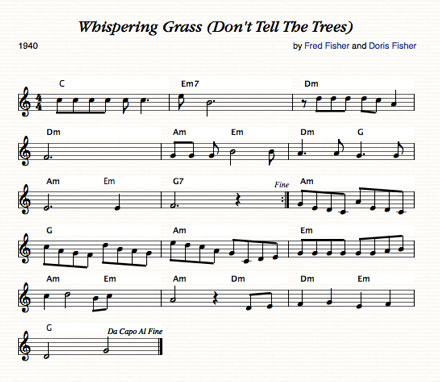Whispering Grass
1940 by The Ink Spots
Why do you whisper, green grass? Why tell the trees what ain't so?
Whispering grass, the trees don't have to know, oh no.
Why tell them all your secrets: Who kissed there long-ago?
Whispering grass, the trees don't need to know.
Don't you tell it to the breeze 'cause she will tell the birds and bees,
and everyone will know because you told the blabbering trees.
Yes, you told them once before. It's no secret anymore.
Why tell them all the old things? They're buried under the snow.
Whispering grass, don't tell the trees, 'cause the trees don't need to know.
Written by Fred Fisher and his daughter Doris, "Whispering Grass" became a big hit in 1940 when recorded by The Ink Spots.
The Ink Spots used to be an uptempo jive group until young tenor Bill Kenny joined, and in 1938 suggested they try ballads instead. He devised the format "top and bottom" where the tenor sang the song right through, followed by a recitation of the bridge by the bass, Hoppy Jones. The tenor returned to close the song. The "Top & Bottom" method sure brought The Ink Spots to the top.
Sunny Side of the Street.
1930 Benny Goodman's Sextet with Peggy Lee
Grab your coat and get your hat, leave your worries on the doorstep;
Just direct your feet to the sunny side of the street.
Can't you hear the pitter-pat? That happy tune is your step.
Life can be so sweet on the sunny side of the street.
I used to walk in the shade with those blues on parade,
But I'm not afraid - this rover's crossed over.
If I never had a cent I'd be as rich as Rockefeller:
Gold dust at my feet on the sunny side of the street.
This 1930 tune is so much the style of Fats Waller composition that some argue that Jimmy McHugh probably bought the rights to his name since Jimmy had already bought other Fats' compositions.
So get your ukulele out and try my Goldenaer easy-play version:
G ||: C | E | F | G | Am | D | Dm G |
(1) Em Dm G :||
(2) C | Gm | C | F | F | Am | D | G | Dm G :|| C
"Amy, Wonderful Amy"


